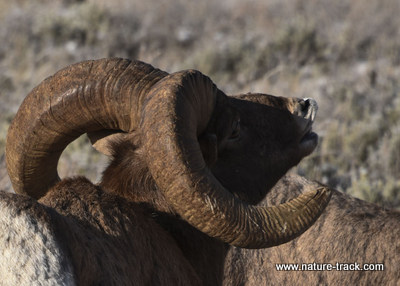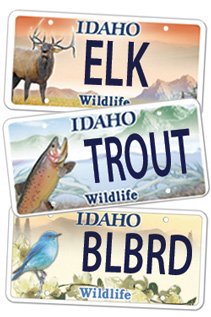Bighorn Experience

A mature ram tests the air by curling back his upper lip. He is checking for pheromones that signal a ewe is ready for breeding.
As I browsed through hundreds of images taken the previous day, the experience came back in a rush, even things that electrons didn’t or couldn’t capture. I had gone to the National Elk Refuge north of Jackson, Wyoming, to photograph bighorn sheep. The mating season was still on and about 100 sheep were observable from the refuge road behind Miller Butte.
I arrived just after sunrise to find most of the sheep still high up against the rocks and bluffs at the top of the small ridge. They were too far away for a decent photograph so I propped the binoculars on the edge of the window. I saw bighorn sheep everywhere—on top of the ridge, below the cliffs and on the cliffs. A red fox even trotted along the ridgeline, oblivious to the sheep and them to it.
With daylight, sheep began to ease up from their beds and head toward the bottom of the hill. One ewe bounced down the very face of the cliff, showing off her skills and a ram trotted down a trail that angled toward the bottom. Others came in groups.
As they edged into the sagebrush covered flat at the bottom, the ewes and lambs began to feed. The rams, though, had other things on their minds. With noses held high and necks outstretched, they sampled the air, trying to detect a female that might be ready to breed. As the day advanced, rams of all sizes crisscrossed the bottom, wandering from one female to the next. Sometimes their approach was nonchalant, other times, apparently detecting a hotter scent, they strode purposefully, upper lip extended to better sample the air, to check out a ewe’s readiness.
It was clear that the males had already sorted out who was boss. For the group I watched, the winner of the headbutting contests of November was a full curl ram. His horns were scratched and chipped and the tips were broomed and split, all part of the price of victory. The younger rams respected him but still checked out every female they could, sometimes even tagging along behind the patriarch as he drifted from ewe to ewe.
I had been here before so it was no surprise when the bighorns converged on parked vehicles. Soon I could hear squeals of delight from children and adults in the nearby cars as the sheep began to lick salt from tires, fenders and bumpers. In short order, my own truck was completely surrounded and I could feel a gentle rocking as almost 20 sheep jockeyed for position around me. When I leaned out the window, huge brown eyes stared back at me from inches away.
A heavy scent, reminiscent of elk but perhaps less musky, drifted in through the truck window. It was a wild scent though, not the odor of domestic sheep. I drank it in for almost four hours as the sheep went about their daily routine and allowed us humans a unique glimpse at their otherwise secretive lives. It was an unforgettable experience, one that will stir a new reverence for nature in all who fall under its spell.

Wildlife License Plates
Great news! as of 2024, there are three NEW designs for license plates. They still are bluebird, cutthroat trout and elk, but they are beautiful.
Idaho Wildlife license plates provide essential funding that benefits the great diversity of native plants and wildlife that are not hunted, fished or trapped—over 10,000 species or 98% of Idaho’s species diversity. Game species that share the same habitats (such as elk, deer, antelope, sage-grouse, salmon, trout) also benefit from these specialty plates.
No state tax dollars are provided for wildlife diversity, conservation education and recreation programs. Neither are any revenues from the sale of hunting or fishing licenses spent on nongame species. Instead, these species depend on direct donations, federal grants, fundraising initiatives—and the Idaho Wildlife license plates.
Both my vehicles have Bluebird Plates. I prefer the bluebird because the nongame program gets 70 percent of the money from bluebird plates, but only 60 percent of the money from elk and trout plates - 10 percent of the money from elk plates supports wildlife disease monitoring and testing programs (to benefit the livestock industry) and 10 percent from cutthroat plates supports non-motorized boat access.
Incidentally, in 2014, the Idaho Legislature denied the Department of Fish and Game the ability to add new plates or even to change the name of the elk and cutthroat plates (very specific) to wildlife and fish plates, a move that would have allowed for changing images occasionally and generating more revenue. It would seem that they believe that we Idahoans don't want a well funded wildlife program.
I think it is time we let the Legislature know that Idahoan support wildlife funding and that we would like to see these generic plates come to fruition.

"WOW. What a phenomenal piece you wrote. You are amazing." Jennifer Jackson
That is embarrassing, but actually a fairly typical response to my nature essays. Since The Best of Nature is created from the very best of 16 years of these nature essays published weekly in the Idaho Falls Post Register (online readership 70,000), it is a fine read. It covers a wide variety of topics including humorous glimpses of nature, philosophy, natural history, and conservation. Readers praise the style, breadth of subject matter and my ability to communicate complex and emotional topics in a relaxed and understandable manner.
Everyone can find something to love in this book. From teenagers to octogenarians, from the coffee shop to the school room, these nature essays are widely read and enjoyed.
Some of the essays here are my personal favorites, others seemed to strike a chord with readers. Most have an important message or lesson that will resonate with you. They are written with a goal to simultaneously entertain and educate about the wonderful workings of nature. Some will make you laugh out loud and others will bring a tear to the eye and warm your heart.
Readers Write:
"You hit a home run with your article on, Big Questions in Nature. It should be required reading for everyone who has lost touch with nature...great job!" Joe Chapman
"We enjoyed your column, Bloom Where Planted. Some of the best writing yet. The Post Register is fortunate to have your weekly columns." Lou Griffin.
To read more and to order a copy, click here or get the Kindle version
Copies are also available at:
Post Register
Island Park Builders Supply (upstairs)
Barnes and Noble in Idaho Falls
Harriman State Park, Island Park
Museum of Idaho
Valley Books, Jackson Wyoming
Avocet Corner Bookstore, Bear River National Wildlife Refuge, Brigham City, Utah
Craters of the Moon National Monument Bookstore, Arco, Idaho
Wildlife License Plates
Great news! as of 2024, there are three NEW designs for license plates. They still are bluebird, cutthroat trout and elk, but they are beautiful.
Idaho Wildlife license plates provide essential funding that benefits the great diversity of native plants and wildlife that are not hunted, fished or trapped—over 10,000 species or 98% of Idaho’s species diversity. Game species that share the same habitats (such as elk, deer, antelope, sage-grouse, salmon, trout) also benefit from these specialty plates.
No state tax dollars are provided for wildlife diversity, conservation education and recreation programs. Neither are any revenues from the sale of hunting or fishing licenses spent on nongame species. Instead, these species depend on direct donations, federal grants, fundraising initiatives—and the Idaho Wildlife license plates.
Both my vehicles have Bluebird Plates. I prefer the bluebird because the nongame program gets 70 percent of the money from bluebird plates, but only 60 percent of the money from elk and trout plates - 10 percent of the money from elk plates supports wildlife disease monitoring and testing programs (to benefit the livestock industry) and 10 percent from cutthroat plates supports non-motorized boat access.
Incidentally, in 2014, the Idaho Legislature denied the Department of Fish and Game the ability to add new plates or even to change the name of the elk and cutthroat plates (very specific) to wildlife and fish plates, a move that would have allowed for changing images occasionally and generating more revenue. It would seem that they believe that we Idahoans don't want a well funded wildlife program.
I think it is time we let the Legislature know that Idahoan support wildlife funding and that we would like to see these generic plates come to fruition.